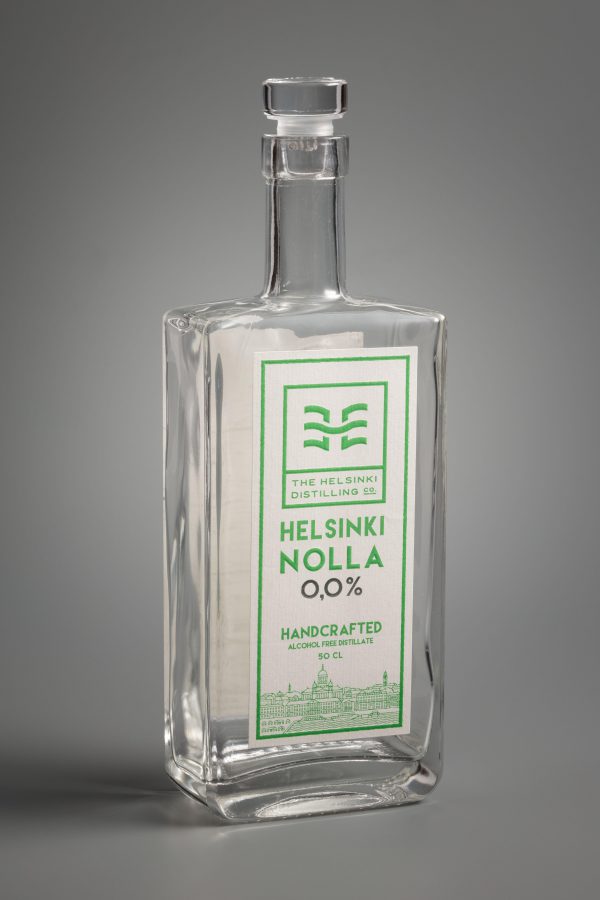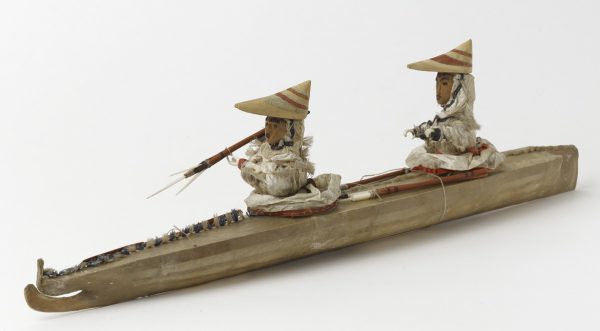Caishen, god of wealth
Artefact of the month – September 2023
Many interesting things have been found in the collection archives of the National Museum while preparing for the move to temporary premises. A new collection worker’s interest was aroused by a Chinese wooden sculpture belonging to the collection donated by the Evangelical Free Church of Finland in 2015. There was very little information about the object; only its place of origin and the name of the person who acquired it were indicated. However, the strong features of the figure depicted in the sculpture and the black tiger gave enough clues and, with a little research, the figure was identified as the Chinese god of wealth, Caishen. But how did the object end up in the national collection and what does it tell us?
About the collection
Accumulated from the Evangelical Free Church’s foreign mission fields in the early 20th century, the collection includes ethnographic artefacts from Asia in particular. There are approximately 700 items in total. Missionaries collected artefacts at their stations for small-scale exhibitions held in Finnish parishes. The purpose of the exhibitions was to raise funds for the missionary work and provide information about the work and the cultures among which it was carried out. In particular, the collection was built by missionary Hilja Heiskanen and mission secretary Elli Hertz in the Himalayas in the early 20th century. Some personal belongings of the mission workers are also included in the collection.
This wooden sculpture (VK6494:613) depicting the Chinese god of wealth, Caishen, belonged to Wilhelmiina Arpiainen (1859–1922), who was the first missionary sent abroad by the Finnish Alliance Mission, the predecessor of the Evangelical Free Church of Finland. Having worked as a primary school teacher for 10 years, Arpiainen first travelled to China in 1893 and then worked in various parts of the country until her death.
For an unmarried woman, going to a foreign country as a missionary required courage and a new way of thinking, and Arpiainen is considered to be a pioneer of Finnish female missionary work. With her good language skills, Arpiainen not only preached the word of God but also helped the people and established congregational schools and new mission centres in China. Arpiainen did not actually collect objects for exhibition use when she was in the field, but the wooden sculpture and other objects left by her became part of the Evangelical Free Church’s collection from her personal estate.
God of wealth
Caishen (also known as Cáishén, Ts’ai Shen, Tsai Shen Yeh and Cai Boxing Jun) is a god of wealth in the Chinese folk religion, Taoism and some Buddhist schools. Caishen’s name consists of the characters for money (cái) and god (shén). The deity is believed to have the power to give and take away riches and is thought to protect his followers from economic misfortunes.
Caishen, like numerous other Chinese gods, has several incarnations as mythical and historical persons. The nine incarnations of Caishen represent the eight compass points and their centre. The best-known of these is the god of the centre, Zhao Gongming, who was promoted from a wise hermit to a marshal. According to stories, he lived in the latter part of the Zhou dynasty (1046–256 BCE). The deity of military wealth, he is often depicted in a combat position with a long black beard, a fierce expression on his face, and an iron sceptre, stick or sword in his hand that can turn stones into gold.
With his various incarnations, Caishen is a popular deity that is still worshipped all over China today. There are many customs and rituals associated with the Chinese New Year celebration in particular. For example, at the turn of the year, it is customary to eat dumplings due to their shape, which resembles a boat-shaped gold ingot (yuanbao). The meal is thought to bring the eater good luck and riches. On the fifth day of the year, one of the presumed birthdays of the deity, incense is burned in temples and people wish each other richness and wealth. At the turn of the year, Caishen is also welcomed into homes by, for example, burning incense, lighting firecrackers and hanging images of the deity on doorposts.
A 100-year-old wooden sculpture
Based on the position, expression and features of the deity depicted in the sculpture, the figure is Zhao Gongming. The deity is often depicted riding a black tiger, like here. In Chinese tradition, the tiger symbolises strong masculine energy. In addition, the tiger refers to the importance of perseverance and hard work in the pursuit of happiness and prosperity, and it reminds us that simply relying on gods does not guarantee success.
The outfit worn by the deity has a red and gold colour, the red symbolising happiness and the gold wealth in Chinese culture. The figure is holding a yuanbao gold ingot in his left hand. The raised right arm has been lost, but the hand can be assumed to have been holding the iron sword usually seen in Zhao Gongming’s hand, turning stones into gold. Behind the sculpture, on the deity’s back, there is a small hole where a small lucky charm or amulet may have been placed.
More than a hundred years old, the sculpture is broken in several places. In addition to the right arm, there are pieces missing from the front and from the left side of the collar, and an iron rivet can be seen on the left side, which may have been holding a piece belonging to the sculpture that has come loose over time. The paint surface is also visibly worn.
We do not know what caused Wilhelmiina Arpiainen to acquire this particular sculpture, whether it had any special significance for her or whether it perhaps ended up in her possession by chance.
Now, more than a hundred years later, the sculpture reminds us of the long history of missionary work and its contradictory nature. It tells the story of the lives of Finnish missionaries on the other side of the world, at a time when travelling abroad was only possible for very few. The sculpture also depicts Chinese culture and its rich syncretic religious tradition. Could the object also tell us something about the cultural heritage of today’s Finns as well as its significance and meanings if we listened close enough?
Rania Taina
Sources and reading
Huotari, Tauno-Olavi & Pertti Seppälä, 1990. Kiinan kulttuuri. Helsinki: Otava.
Hämelin, Eila & Sisko Peltoniemi, 1990. Edelläkävijät: vuosisata vapaakirkollista lähetystyötä. Hämeenlinna: Päivä Osakeyhtiö.
Ihamäki, Kirsti (ed.), 1983. Matkoilla: Suomen lähetysseura 125 vuotta. Helsinki: Kirjaneliö.
Kohn, Livia, 2001. Daoism and Chinese Culture. Magdalena, NM: Three Pines Press.
Laing, Ellen Johnston, 2013. “Living Wealth Gods” in the Chinese Popular Print Tradition. Artibus Asiae 73, no. 2: 343–363. http://www.jstor.org/stable/24240817.
Nadeau, Randall Laird (ed.), 2012. The Wiley-Blackwell Companion to Chinese Religions. Malden; Oxford: Wiley-Blackwell.
Palmer, Martin, 1998. Taolaisuus (Finnish translation of The Elements of Taoism). Helsinki: Tammi.
Rautamäki, Vappu, 1981. Lähetystyömme tänään: katsaus v. 1891 alkaneeseen Suomen vapaakirkon lähetystyöhön kolmannessa maanosassa. Hämeenlinna: Päivä Osakeyhtiö.
Salmensaari, Sulo S., 1957. Suomen vapaakirkko: piirteitä sen synnystä ja kehityksestä. Helsinki: Päivä Osakeyhtiö.
Thompson, Laurence G., 1996. Chinese Religion: An Introduction. Belmont, Calif. : Wadsworth Publ. Company.
Williams, C. A. S., 1976. Outlines of Chinese symbolism and art motives: an alphabetical compendium of antique legends and beliefs, as reflected in the manners and customs of the Chinese. New York, NY: Dover Publications.
China Knowledge: http://www.chinaknowledge.de/Literature/Religion/personscaishen.html
Encyclopedia Britannica: https://www.britannica.com/topic/Caishen
National Biography of Finland (in Finnish): https://kansallisbiografia.fi/kansallisbiografia/henkilo/6927
The China Project: https://thechinaproject.com/2020/05/18/all-about-the-chinese-god-of-money/
The Symbol Sage: https://symbolsage.com/chinese-god-of-wealth/
Wikipedia, Caishen: https://en.wikipedia.org/wiki/Caishen
Wikipedia, Suomen Vapaakirkon lähetystyö (Mission of the Evangelical Free Church of Finland, in Finnish): https://fi.wikipedia.org/wiki/Suomen_Vapaakirkon_l%C3%A4hetysty%C3%B6
Wikipedia, Zhao Gongming: https://en.wikipedia.org/wiki/Zhao_Gongming




-
2024
-
2023
-
 Book cover
Book cover
-
 Pennies found in Häme Castle
Pennies found in Häme Castle
-
 Ruler received by Aleksis Kivi as a consolation gift
Ruler received by Aleksis Kivi as a consolation gift
-
 Caishen, god of wealth
Caishen, god of wealth
-
 Sober curious phenomenon
Sober curious phenomenon
-
 Summer shoes made of fish leather
Summer shoes made of fish leather
-
 Book briefcase of the Finnish Seamen's Service
Book briefcase of the Finnish Seamen's Service
-
 Nyytinkirukki lace pillow
Nyytinkirukki lace pillow
-
 Arctic vessels and scale models
Arctic vessels and scale models
-
 Portrait of a young dandy: Carl Gustaf Mannerheim
Portrait of a young dandy: Carl Gustaf Mannerheim
-
 Painted Wall Covering in the Devil’s Chamber
Painted Wall Covering in the Devil’s Chamber
-
 Šerkämä – Women’s brooch
Šerkämä – Women’s brooch
-
-
2022
-
2021
-
2020
-
2019
-
2018